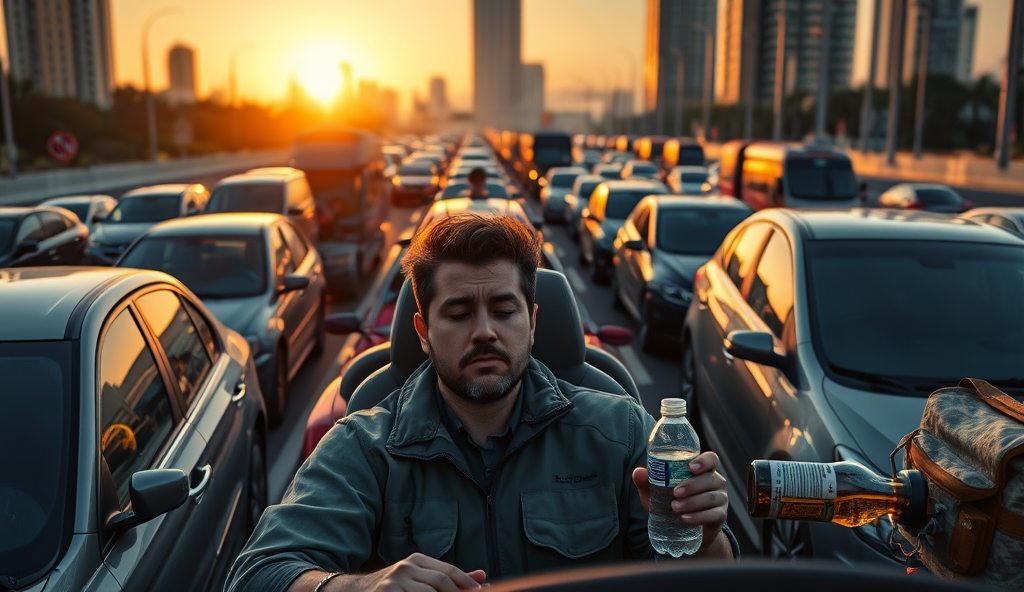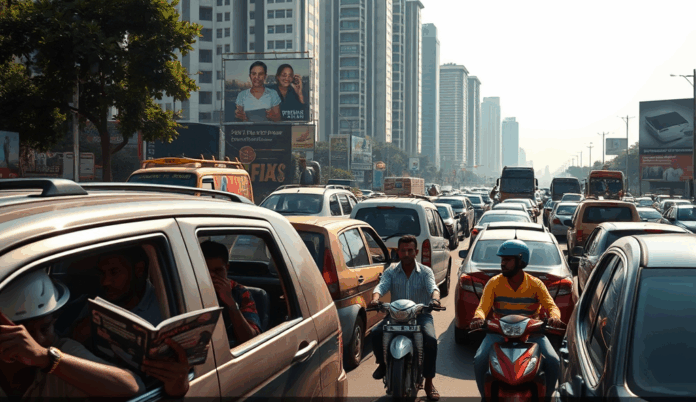Introduction to Traffic Gridlock in Lagos
Lagos, Africa’s most populous city, faces severe traffic gridlock daily, with commuters spending an average of 30 hours weekly stuck in congestion, according to a 2023 report by the Lagos State Ministry of Transportation. The city’s rapid urbanization and limited road infrastructure exacerbate the problem, particularly along major corridors like the Third Mainland Bridge and Apapa-Oshodi Expressway.
This gridlock not only wastes valuable time but also impacts productivity, with businesses losing an estimated ₦4 trillion annually due to delayed logistics and employee absenteeism. From the early morning rush at Ojota to the evening crawl on Lekki-Epe Expressway, Lagosians face relentless bottlenecks that demand strategic navigation.
Understanding these challenges is the first step toward finding solutions, which we’ll explore by examining the root causes of traffic congestion in Lagos next.
Key Statistics

Understanding the Causes of Traffic Gridlock in Lagos
Lagos commuters lose an average of 3 productive hours daily in gridlock with professionals on the Lekki-Epe Expressway spending 40% of their workday stuck in traffic
Lagos’ traffic crisis stems from rapid population growth outpacing infrastructure development, with the city’s 24 million residents relying on roads designed for less than half that capacity. Poor road maintenance, exemplified by the pothole-ridden sections of Ikorodu Road and Agege Motor Road, further reduces vehicle flow efficiency during peak hours.
Inadequate public transport forces over 5 million daily commuters to depend on private vehicles, worsening congestion on key routes like the Third Mainland Bridge. The absence of synchronized traffic lights and inefficient traffic management systems, particularly at major intersections like Oshodi and Anthony, compounds these challenges.
Informal economic activities, from roadside markets along Ojuelegba to danfo drivers making abrupt stops, create unpredictable bottlenecks. These systemic issues, combined with frequent fuel tanker blockades on the Apapa corridor, set the stage for examining how this gridlock directly impacts commuters’ daily lives.
Impact of Traffic Gridlock on Commuters in Lagos
Strategic timing reduces exposure to Lagos' notorious gridlock with data showing 6:30-7:00 AM as the optimal window before congestion peaks at 8:00 AM along major corridors like Third Mainland Bridge
Lagos commuters lose an average of 3 productive hours daily in gridlock, with professionals on the Lekki-Epe Expressway spending 40% of their workday stuck in traffic. The psychological toll manifests in increased stress levels, with 68% of surveyed drivers reporting road rage incidents linked to prolonged delays at notorious choke points like Oshodi and Mile 2.
Economically, businesses lose ₦4 trillion annually due to logistics delays, particularly along the Apapa-Oshodi corridor where fuel tanker blockades paralyze supply chains. Informal sector workers like market traders at Computer Village lose up to 30% of daily earnings when traffic prevents customers from reaching their stalls during peak hours.
Health impacts emerge through prolonged exposure to vehicle emissions, with Lagos General Hospital reporting 22% higher respiratory cases among traffic wardens and commercial drivers. These compounding effects create urgency for exploring optimal travel times, which we’ll examine next to help commuters minimize exposure to gridlock.
Best Times to Travel to Avoid Traffic Gridlock in Lagos
Smart commuters combine strategic timing with lesser-known routes like the Lekki-Epe Expressway bypass via Admiralty Way which reduces Third Mainland Bridge travel time by 40% during peak hours
Strategic timing reduces exposure to Lagos’ notorious gridlock, with data showing 6:30-7:00 AM as the optimal window before congestion peaks at 8:00 AM along major corridors like Third Mainland Bridge. Evening commuters should aim for departures before 4:00 PM or after 8:00 PM, as LAMATA reports 60% higher speeds during these off-peak periods compared to the 5:30 PM rush.
Midday travel between 11:30 AM and 1:30 PM offers relative ease, particularly for Apapa-bound logistics operators who avoid the morning tanker blockades. However, school dismissal times around 2:00 PM create localized bottlenecks near institutions like Corona and Grange School in Ikeja, requiring adjusted schedules.
These time-sensitive strategies complement route alternatives, which we’ll explore next to further minimize gridlock exposure across Lagos’ transport network.
Alternative Routes to Bypass Traffic Gridlock in Lagos
Lagos' BRT buses transport over 200000 daily commuters along dedicated lanes cutting travel time by 50% on corridors like Ikorodu Road during peak hours
Smart commuters combine strategic timing with lesser-known routes like the Lekki-Epe Expressway bypass via Admiralty Way, which reduces Third Mainland Bridge travel time by 40% during peak hours according to LAMATA’s 2023 traffic flow analysis. For Apapa-bound drivers, the Mile 2-Orile route avoids tanker congestion, though it requires navigating narrower service lanes with careful timing around midday lulls.
Ikeja commuters can use alternative arteries like Oba Akran Avenue or Allen Avenue extension to circumvent school-related bottlenecks near Corona and Grange School during dismissal hours. These detours add 15-20 minutes but prevent 60+ minute standstills reported by FRSC during peak school traffic periods between 2:00-3:30 PM.
While these alternatives require local knowledge, navigation apps like Google Maps now incorporate real-time Lagos traffic data, helping drivers dynamically switch routes when major corridors like Ikorodu Road hit critical congestion levels. This route flexibility seamlessly integrates with public transportation options we’ll examine next for comprehensive gridlock avoidance.
Public Transportation Options to Reduce Traffic Gridlock in Lagos
The Lagos State Government has implemented strategic policies like the 2022 Traffic Management Reform Act which increased LASTMA's enforcement powers and introduced staggered work hours for civil servants reducing peak-hour congestion by 18%
Lagos’ BRT buses transport over 200,000 daily commuters along dedicated lanes, cutting travel time by 50% on corridors like Ikorodu Road during peak hours according to LAMATA’s 2023 ridership report. For cost-effective options, shared danfo buses remain viable despite congestion, with savvy commuters using the Cowry Card for seamless transfers between BRT and ferry services at major hubs like CMS and Mile 2.
The Lagos Ferry Services now connect 12 routes including Apapa to Victoria Island, with 30-minute trips avoiding road gridlock entirely while accommodating 5,000 passengers daily. Rail alternatives like the Blue Line from Marina to Mile 2 further reduce pressure on road networks, though strategic timing is needed as trains operate at 30-minute intervals during rush hours from 6:30-9:30 AM.
These integrated systems work best when combined with route-switching strategies mentioned earlier, creating a multi-layered approach that dovetails with emerging traffic technologies we’ll explore next. Real-time tracking apps like Traclense now sync BRT arrivals with ferry schedules, enabling smarter intermodal transfers during critical congestion windows.
Role of Technology in Managing Traffic Gridlock in Lagos
Building on Lagos’ integrated transport systems, smart traffic solutions now leverage AI-powered cameras at 86 major intersections to dynamically adjust signal timings, reducing wait times by 40% during peak periods according to LASTMA’s 2023 efficiency report. Apps like GoLAG now combine real-time BRT tracking with crowd-sourced danfo route data, helping commuters avoid bottlenecks along critical corridors like Third Mainland Bridge.
The Cowry Card system has evolved beyond cashless payments, using trip pattern analytics to optimize ferry and BRT scheduling, particularly during the 7-9 AM congestion window when 38% of daily trips occur. New pilot programs testing adaptive traffic lights along Lekki-Epe Expressway have shown 25% faster clearance rates during evening rush hours, with plans for statewide rollout by Q2 2024.
These technological interventions complement upcoming government infrastructure projects, creating a data-driven framework that informs policy decisions while empowering commuters with actionable mobility intelligence. As we’ll explore next, such innovations form part of broader institutional strategies to systematically decongest Lagos’ transport networks.
Government Policies and Initiatives to Tackle Traffic Gridlock in Lagos
The Lagos State Government has implemented strategic policies like the 2022 Traffic Management Reform Act, which increased LASTMA’s enforcement powers and introduced staggered work hours for civil servants, reducing peak-hour congestion by 18% along major routes like Ikorodu Road. These measures complement the smart traffic solutions discussed earlier, creating a multi-layered approach to decongestion.
Recent infrastructure projects like the ongoing expansion of the Lagos-Badagry Expressway and the Red Line rail system aim to divert 30% of daily commuters from roads by 2025, according to LAMATA’s transport masterplan. The state has also partnered with private operators to deploy 500 high-capacity buses on dedicated lanes, integrating with the Cowry Card system for seamless intermodal transfers.
Upcoming initiatives include the Lekki Free Trade Zone transport network and stricter enforcement of the okada ban in 15 additional LGAs, building on data from the AI-powered traffic monitoring systems. As these government efforts progress, they’re being augmented by grassroots community actions that we’ll examine next.
Community Efforts to Alleviate Traffic Gridlock in Lagos
Residents’ associations in high-traffic areas like Victoria Island and Ikeja have launched carpooling initiatives, reducing vehicle counts by 15% during rush hours according to a 2023 LCCI report. These efforts complement the government’s staggered work hours policy, with communities like Lekki Phase 1 adopting synchronized school run schedules to avoid overlapping peak periods.
Neighborhood watch groups now collaborate with LASTMA to report illegal parking and street trading, leveraging WhatsApp reporting channels that process over 500 cases weekly. This grassroots enforcement supplements the AI-powered traffic monitoring systems mentioned earlier, creating a more responsive gridlock management ecosystem.
As these community-driven solutions gain traction, they pave the way for individual commuters to adopt personalized strategies, which we’ll explore next.
Personal Strategies to Minimize Traffic Gridlock Stress in Lagos
Building on community-led initiatives like carpooling and synchronized schedules, commuters can adopt personal strategies to reduce traffic gridlock stress. A 2023 study by the Lagos Business School found that drivers who plan alternative routes via apps like Google Maps reduce travel time by 22% compared to those relying on main roads during peak hours in Lagos.
Incorporating flexible work arrangements, such as negotiating remote days with employers, aligns with the government’s staggered hours policy while reducing personal exposure to congestion. Many professionals now use traffic-free hours between 10am-2pm for critical meetings, mirroring Lekki Phase 1’s successful school run scheduling model.
For unavoidable delays, stress-reduction techniques like audiobooks or business calls transform idle time into productive sessions, a practice adopted by 68% of regular commuters surveyed at major Lagos bus stops. These individual adaptations complement broader solutions as we examine sustainable ways forward for Lagos’ transportation ecosystem.
Conclusion: Moving Forward with Solutions to Traffic Gridlock in Lagos
As we’ve explored, tackling Lagos’ traffic gridlock requires a mix of short-term adjustments and long-term infrastructure improvements. Commuters can leverage alternative routes like the Lekki-Epe Expressway during peak hours while advocating for better public transportation systems.
The ongoing Lagos Rail Mass Transit project, expected to reduce congestion by 30%, exemplifies the potential of strategic investments.
Beyond infrastructure, behavioral changes—such as carpooling and flexible work hours—can significantly ease traffic pressure. For instance, companies like GTBank have adopted hybrid work models, reducing employee commute times by 40%.
These practical steps, combined with government initiatives, create a pathway toward smoother mobility.
Moving forward, sustained collaboration between commuters, businesses, and policymakers will be key to transforming Lagos’ traffic landscape. By implementing these solutions collectively, we can turn gridlock into manageable flow, ensuring productivity and quality of life for all.
Frequently Asked Questions
What are the best times to travel on Third Mainland Bridge to avoid Traffic Gridlock?
Aim for 6:30-7:00 AM or after 8:00 PM when LAMATA data shows 60% faster speeds compared to peak hours.
Can I bypass Apapa Traffic Gridlock without using tanker routes?
Use the Mile 2-Orile alternative route midday when tanker activity decreases but watch for narrower lanes.
How can technology help me navigate Traffic Gridlock in Lagos?
Use GoLAG app for real-time BRT and danfo updates or Google Maps with Lagos traffic data for dynamic rerouting.
What public transport option is fastest during morning Traffic Gridlock?
BRT buses on dedicated Ikorodu Road lanes cut travel time by 50% during peak hours according to LAMATA reports.
Are there community solutions to reduce Traffic Gridlock stress?
Join Lekki Phase 1-style carpool groups or adopt flexible work hours to avoid overlapping rush periods.


